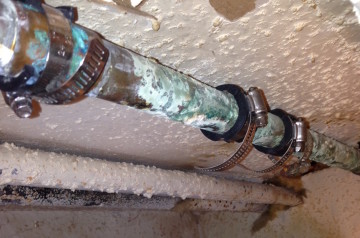Copper Corrosion…It’s the Pits.
Copper piping has been used in domestic water supply systems for nearly 100 years. Originally, copper piping was projected to last 20-25 years, but with changes in water chemistry and other environmental factors, the rate of corrosion has accelerated, and the longevity of copper pipes has become a valid concern.The Causes
Many theories and a lot of research exist regarding the primary cause of copper pipe corrosion and it can be difficult to identify one single cause. Once you navigate through the media noise and scientific engineering jargon, it’s clear that copper pitting corrosion is caused by a combination of factors–including improper pipe installation, bacteria, electrical grounding, soil acidity, pipe manufacture quality, water chemistry, the environment and more.
In hotbed areas like Florida, Texas and California (where one could argue copper corrosion is an epidemic), there are increasing reports of premature copper corrosion and leaking pipes, often in buildings that are just a few years old. But, it’s not limited to just those three states. Trends show that states with higher amounts of chloramines and sulfites have copper pitting problems, ultimately resulting in the ubiquitous “pinhole leak” phenomenon.
But why the sudden increase in copper corrosion?
Ironically, it’s the result of an increased public health effort to keep people safe. Municipalities, following state and federal standards for safe drinking water, add chloramines and sulfites to treat the local water and keep the drinking water free of bacteria (and safer to drink). Chloramines are chemical compounds containing a mixture of chlorine and ammonia that extend the disinfecting power of chlorine in drinking water. Unfortunately, it appears the unintended consequence is how these chemicals attack copper (at a molecular level) resulting in corrosion, pitting and leaks. With the increase in safe drinking water standards over the last few years, we have seen a corresponding decrease in the usable life of copper supply piping systems in buildings across the country and several studies are currently underway trying to prove this correlation.
The result?
Corrosion leads to pitting, and pitting leads to pinhole leaks. Quite often, these leaks may go undetected for months, ultimately causing mold and mildew growth. Even worse, due to weakening at the point of pitting, the pipe can suddenly break, causing catastrophic damage and expensive repairs. Despite the numerous studies that have been conducted on the subject of copper corrosion, fully understanding the problem is still a challenge and remediation can be difficult.
So, what options do you have to prevent catastrophe from striking at your property? Ideally, you want to discover the corrosion and pitting before pinhole leaks develop and formulate an appropriate remediation plan.

All too often, we see pipes that have been clamped with a piece of foam and a radiator clamp to stop pinhole leaks. This may be a quick fix that is easy for maintenance staff to handle, but it is not a viable long-term solution. Many times, clamped pipes are a signal that a more catastrophic leak is right around the corner.
Our recommendations:
- If you have a single leak, your best option is to replace the section of compromised pipe to limit further damage to weakened areas.
- If you have recurring leaks or multiple points of failure across your property, repiping the corroded copper with CPVC or PEX piping is your best alternative.
Unfortunately, in any situation where you have copper pipe corrosion and pitting, there are going to be costs involved, but over time, replacing your pipes will save your property money compared to the high costs of water damage and increased insurance premiums from repeated leaks.

